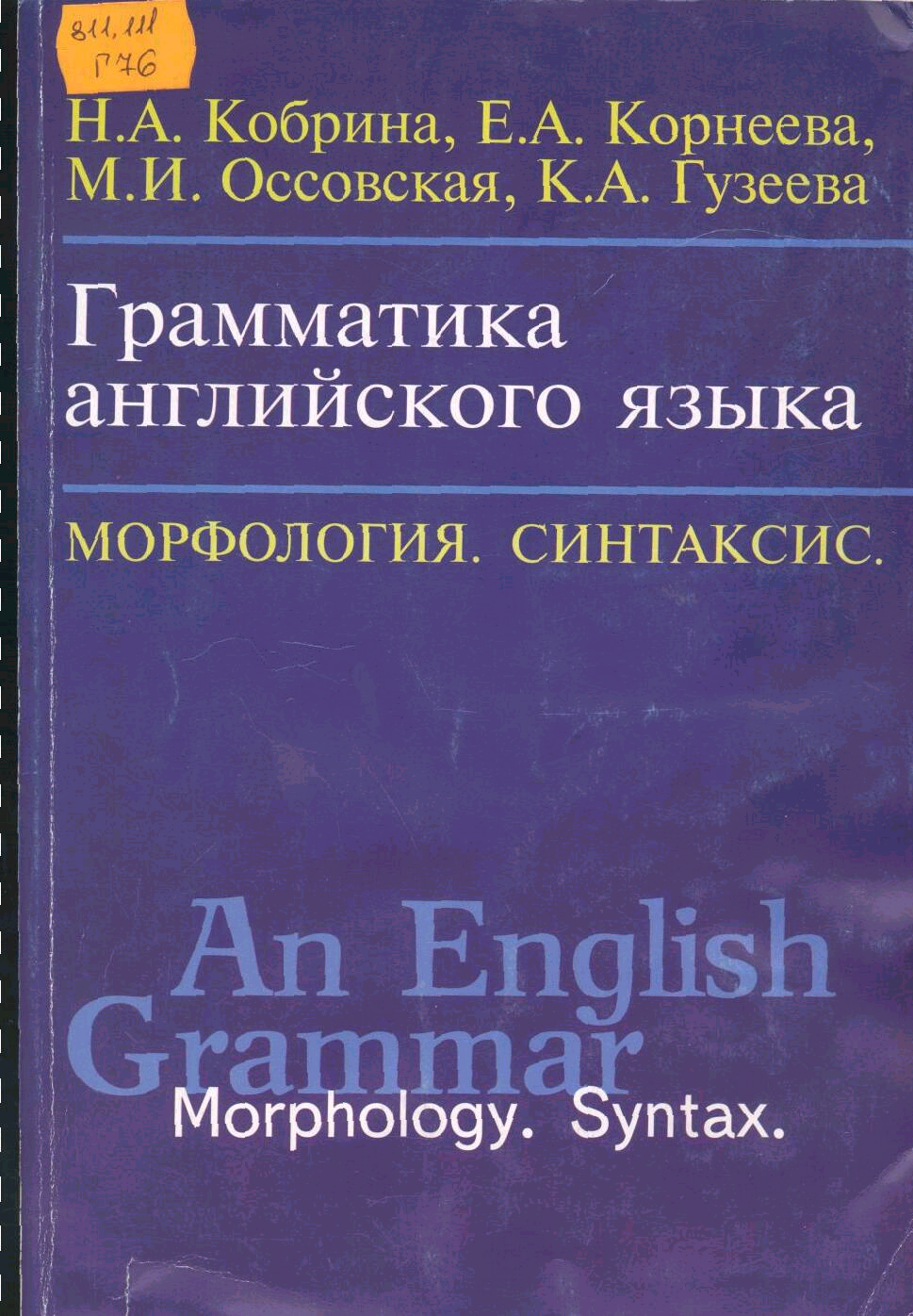Учебник Кобрина. Грамматика. Синтаксис.1999. Учебное пособие для студентов педагогических институтов и университетов по специальности 2103 "Иностранные языки". Спб., Союз, 1999. 496 с
 Скачать 3.61 Mb. Скачать 3.61 Mb.
|
|
http://all-ebooks.com :: только самые лучшие книги! ааа  Н. А. КОБРИНА, Е. А. КОРНЕЕВА, М. И. ОССОВСКАЯ, К. А. ГУЗЕЕВА ГРАММАТИКА АНГЛИЙСКОГО ЯЗЫКА Морфология. СинтаксисСОЮЗ С.-ПЕТЕРБУРГ 1999 ББК 81.2 Англ. К 85 Н. А. Кобрина, Е. А. Корнеева, М. И. Оссовская, К. А. Гузеева
Пособие представляет собой второе дополненное и переработанное издание ранее изданного курса практической грамматики в двух частях - Морфология (М., Просвещение, 1985) и Синтаксис (М., Просвещение, 1986). Пособие было допущено Министерством просвещения СССР в качестве учебного пособия для студентов педагогических институтов по специальности №2103 "Иностранные языки". Рецензенты: Кафедра грамматики английского языка Минского ГПИИЯ; профессор М. Я. Блох (МГПИ им. В. И. Ленина) Авторы уделяют особое внимание тем грамматическим явлениям, которые не имеют аналогов в русском языке.
Новелла Александровна Кобрина, Елена Александровна Корнеева, Мария Ильинична Оссовская , Ксения Александровна Гузеева ГРАММАТИКА АНГЛИЙСКОГО ЯЗЫКА Морфология. СинтаксисУчебное пособие Подписано в печать 25 июля 1999 г. Формат 70х1001/16. Гарнитура «Таймс». Бумага офсетная. Печать офсетная. Объем: 31,0 печ. л. Тираж 10 000 экз. Заказ № 830. Издательство «СОЮЗ» 195197, Санкт-Петербург, ул. Васенко, 6. Отпечатано с готовых диапозитивов в ГИПК «Лениздат» (типография им. Володарского) Государственного комитета РФ по печати. 191023, Санкт-Петербург, наб. р. Фонтанки, 59. ПРЕДИСЛОВИЕ Настоящее пособие дает достаточно полное и систематическое описание строя современного английского языка, подробно излагая разделы грамматики, предусмотренные Программой Министерства просвещения СССР для студентов I-III курсов факультетов и отделений английского языка педагогических институтов. Задача пособия состоит в том, чтобы дать студентам практическое знание грамматического строя английского языка, необходимое для владения языком. Основной материал учебника излагается с позиций современной английской литературной грамматической нормы, однако фиксируются и американские варианты, а также коллоквиализмы и архаические формы, используемые в поэзии. Каждой новой теме предпосылаются краткие сведения, дающие общую характеристику описываемого явления. Пройденный материал рекомендуется закреплять сериями упражнений, среди которых значительное место должны занимать упражнения коммуникативного типа. Для удобства пользования весь материал учебника разделен на параграфы, имеющие сквозную нумерацию. Основной иллюстративный материал почерпнут из англо-американской литературы последних десятилетий. Пособие было апробировано в течение нескольких лет на английском отделении факультета иностранных языков РГПУ им. А. И. Герцена. АвторыINTRODUCTION The grammatical system of English, like that of any other language, possesses its own peculiar features. The English language has comparatively few grammatical inflections. They are the plural and the Genitive case endings of some nouns, the comparative degree endings of some adjectives and adverbs; personal inflections of verbs are confined to the third person singular and the opposition of the forms was - were. What is most characteristic of these inflections in comparison with Russian is that they are more unified. Thus the plural ending -s in nouns is used with the majority of count nouns. The few exceptions (such as tooth - teeth, goose - geese, child - children, ox - oxen) are regarded as obsolete forms. In the sphere of the verb, however, many complications arise, as there is no such regularity among the past tense and participle II forms. Some of them are formed with the inflection -ed (help - helped – helped), others by means of root vowel change (bring - brought - brought, come - came - come). The latter are considered as irregular verbs. Alongside synthetic forms, the verb has an elaborate system of analytical forms (most of the tense, aspect and perfect forms, the passive voice forms, most of the subjunctive mood forms). The analytical forms, include an auxiliary verb, as the bearer of the grammatical meaning, and a notional part: has gone, was sent, would like, to be posted, being done, having been done, etc. Many words are not inflected at all: most adjectives and adverbs, modal words, statives, non-count nouns, conjunctions, prepositions, particles and interjections. Moreover, most words are devoid of any word-forming (derivational) morphemes which would show that they belong to a certain class. This lack of morphological distinctions between the classes accounts for the fact that a great number of words (both notional and functional words) may easily pass from one class to another, their status being determined mainly syntactically, by their function in the sentence. The prevailing role of syntax over morphology is also revealed in the fact that words, phrases and clauses may be used in the same functions. The order of elements in the English sentence is fixed to a greater degree than in inflected languages (as the Russian language). The order subject - predicate - object is most characteristic of statements, and any modification of it is always justified by either stylistic or communicative considerations. Attributes may precede or follow head-word, the first pattern being more usual. The most mobile element in the sentence is the adverbial, but that can be explained by its reference to different parts of the sentence. A most peculiar feature of English is a special set of words employed as structural substitutes for a certain part of speech: noun substitutes (one, that), the verb substitute (do), the adverbs and adjective substitute (so). |
